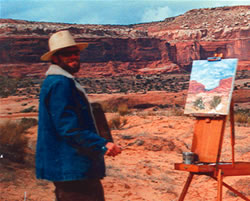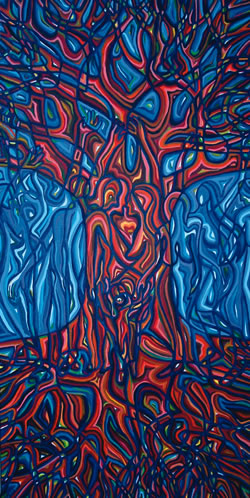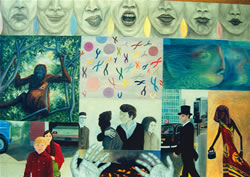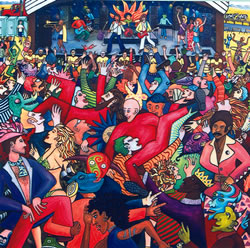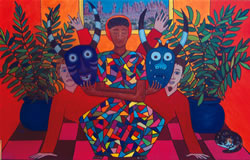A painting is a reflection
of the artist much like a child reflects a parent. The artist,
consciously and otherwise, imparts portions of his experiences
and philosophies into a work of art.
This connection between creator and creation
makes studying the body of work of an artist particularly
fascinating since it’s a way of delving into the mind
of the person. For example, before Picasso painted his signature
cubist faces, he explored a “Blue Period,” in
which he realistically depicted figures in varying hues of
blue. The transition from focusing on a color that casts
a depressing tone to each canvas to what eventually became
a revolutionary interest in strong linear and colorful abstract
paintings is intriguing since it reflects the evolution of
a creative, perceptive mind.
Much like Picasso’s later portraits which depict fractured
facets of the face from one point of perception, Alex Burbidge’s
portfolio includes such varying styles, revealing many sides
to an inquisitive, insightful spirit.
Not only is Burbidge prolific in the amount of work he has
created, but he has also explored so many divergent ideas
and ways to depict them through art that he eludes being
pinned down by a label.
To begin with, I was under the impression that he was a sculptor
since my first introduction to his work was at the Moab Abstracts
exhibit in February, which featured modern art by six local
residents. Burbidge’s contribution to the show was
sculptures made of wire.
Having majored in sculpture at the University of Utah, Burbidge
has created other three-dimensional works, including carved
figurines and masks, a subject that fascinates him.
The hallway of his home is decorated with an impressive collection
of masks. Some are ones he created himself and others have
been acquired as gifts or from his own travels. The materials
they are made of include wood, paper mache, feathers and
beads. The ones designed by Burbidge are designed to be worn,
a manifestation of his belief that people wear figurative
masks all the time. This idea surfaces in much of his artwork.
Nowadays, painting is the primary medium through which he
explores this philosophy.
Although my encounters with Burbidge have been few, he strikes
me as a soft-spoken man, keeping his tone level and low,
hands anchored under his crossed arms. Juxtaposing this impression
of the artist against his vibrant work echoing of social
commentary reveals how he uses his paintings as a forum for
eloquent visual discourse and social commentary.
Burbidge likes to explore diverse styles, moving from one
series of paintings to another. Perusing his portfolio is
like reading all the novels of one author. Although his style
evolves, becoming more sophisticated in his later works,
the central themes remain the same.
Clearly, he is an observer of human nature. One of his earlier
series of paintings that he began in 2002 is made up of canvases
that trick the eye into believing they are a collage of images.
In “Human Ideology: One Step Forward, Two Steps Backwards”,
he depicts an arrangement of what appears to be disconnected
images, ranging from an orangutang hanging out of a tropical
forest to a black-and-white image of a well-dressed couple
embracing. The latter image is sandwiched between a picture
of swimming chromosomes above it and a burning hillside below
it, reflecting the biological underbelly of the romantic
scene.
Seven faces displaying varying expressions run along the
top of the painting, representing the range of emotions art
can extract from the viewer. Those faces appear to be an
invitation or a warning to the viewer that these images are
meant to evoke an array of feelings and thoughts.
Burbidge effectively uses different tones to distinguish
one image from another. The warm colors of the African tribal
woman contrast to the cooler blues of the urban man wearing
a top hat. The most arresting aspect of the painting is the
pair of gray hands at the bottom of the canvas that seem
to rest in a supplicating pose over the collage. In the pose,
Burbidge has caught the feeling of despair and wonder since
it is not clear whether the hands are raised in anguish or
are being held up in order to admire them and what they can
accomplish.
The other paintings in this series display the same raw emotion,
laying Burbidge’s ideas and questions out directly
on the table. Another similar painting includes images of
a semi-dressed woman kneading dough, a wolf howling and a
soldier loading a gun. The center of this painting brandishes
a caption reading, “Human Idealogy: Eat it, Kill it
or F**k It.”
In his next series, entitled “Spinning on a Tilted
Axis,” Burbidge continues to address the human condition
with a forthright voice. Using bold colors, where red and
royal blue dominate, he creates vibrant compositions that
demand attention.
His canvases are populated by a multitude of interlaced figures,
creating movement and chaos in the composition. This series
seems less didactic than the previous, and appears to be
more of an exploration of the relationships between people,
cultures and religion.
A consistent figure in all of these paintings is “Mama
Gaya,” who is identifiable by her multi-colored gown,
symbolic of the tapestry of life and all its tones and shapes.
Her face wears a serene expression of calm or enlightenment.
In “When Your Insides Are Out and Outsides Are In,” she
is depicted with her eyes closed in what appears a meditative
pose while holding up horned masks in her crossed arms. The
masks partially cover the faces of two men crouching behind
her, each with an opposing expression to the one worn by
the mask in front of his face. It is not clear if Mama Gaya
is helping to take off the masks or switching them from one
man to the other.
This idea of people hiding behind masks surfaces clearly
throughout this series of paintings, evidenced in a depiction
of the crucifixion where every figure below Christ is wearing
a full-facial mask.
Religion, both in terms of philosophy and cultural identity,
seems to be a topic Burbidge does not tire of exploring,
and it plays a central role in his next series of paintings,
entitled “The Travels of Jesse and Buddy.” Playing
on the names of Jesus and Buddha, Burbidge uses these paintings
to explore how these central figures of major world religions
fit into quotidian life today by placing them in familiar
scenes, such as a rodeo, a volleyball tournament, a barbershop
and a mosh pit.
These paintings continue to use bold color and intentionally
flat dimensions, which imbue them with a cartoon-like quality,
a playful invitation to consider the more serious ideas the
painter is exploring through the composition. This series
clearly reflects how Burbidge has emerged from a didactic
phase into one of contemplation and dialogue.
The ideas that drive him remain the same. In fact, the “Mama
Gaya” figure makes cameo appearances throughout this
later series, appearing in the background of most of these
paintings. Burbidge explores how religions blend in a global
world, reflected in the number of ethnicities represented
by the people who populate these paintings. The cartoon-like
quality of this series belies the depth with which he considers
these complicated ideas.
His most recent series of paintings is taking him into the
world of abstracts. The bold colors and lines of his past
paintings are still present in these newest ones. Although
recognizable images appear in the current works, the overall
effect is non-representational. Burbidge begins with an idea
and overlays colors and marks until the canvas takes on an
appearance of its own. The original image remains, but the
viewer has to look for it.
In “Tree of Life-Study,” a painting Burbidge
created for his wife, Julia, the turquoise and red lines
pop out in the shape of a tree. Looking closely at the tree,
a man and woman facing each other appears in the trunk. Between
their torsos lie concentric hearts and between their legs
is the shape of a child. Other recognizable figures emerge
from the leaves, but the dominating image of the painting
is color and lines.
Along with these divergent series, Burbidge has continued
painting nature, in the form of floral still lifes, and most
currently, “pleine aire” scenes of the desert
landscapes. He works with oils, using a palette knife to
create a thick texture. Where he is willing to turn a critical
and contemplative eye on the human condition, he depicts
nature in its softest, most docile moments, capturing spring
vegetation along a river, autumn leaves and curvaceous sandstone.
Reviewing Burbidge’s portfolio is an introduction to
the artist because he imbues so much of his work with his
personal philosophies. His paintings, particularly those
which compose a series, act like masks. Behind each series
lies a part of the man who created them.
Like the Wizard of Oz, Burbidge prefers standing behind his
creations, as evidenced by the pen name “Alea” he
uses to sign his works. Also like the Wizard, he succeeds
in creating such vivid, fascinating and revealing paintings
that the viewer can easily forget to peek around and see
the man quietly pulling the strings in the background, an
interesting juxtaposition between a soft-spoken man and his
vociferous ideas.
|
